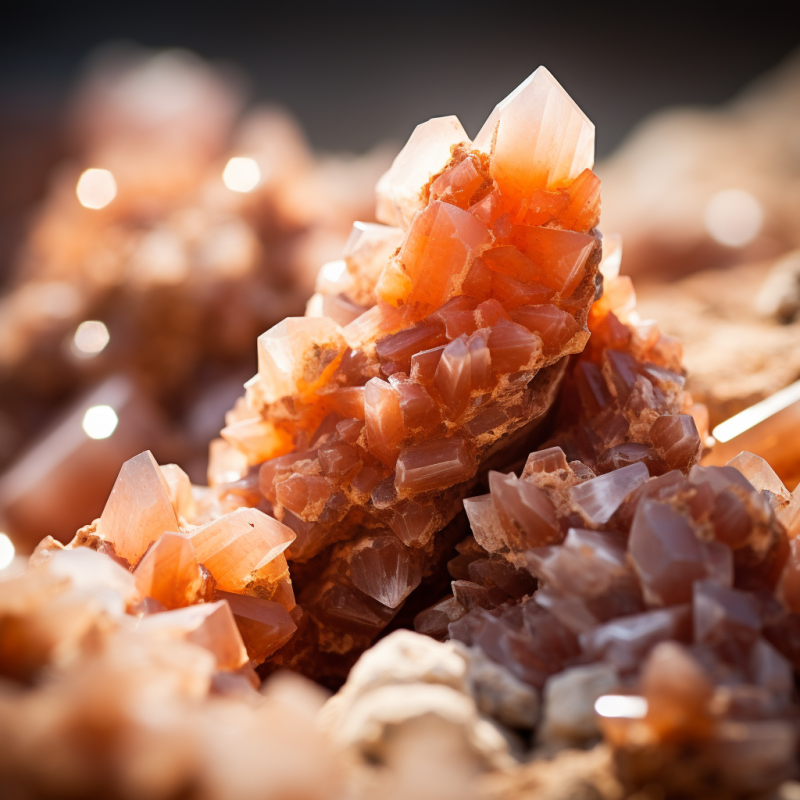Understanding the Geological Characteristics of Aragonite
Aragonite is a fascinating mineral that plays an important role in Earth’s natural processes. In this article, we will take an in-depth look at the geological characteristics of aragonite. We will explore what aragonite is, how it forms, where you can find it, and why it matters in both nature and science. Whether you are a student, a hobbyist rock collector, or simply curious about minerals, this guide is designed to help you understand aragonite in simple, clear American English. We will cover long-tail keywords like “geological characteristics of aragonite,” “aragonite crystal structure,” “calcium carbonate minerals,” and “aragonite formation process” to boost search engine ranking and help you find the information you need.
Introduction
Aragonite is a form of calcium carbonate, similar to calcite, but with a unique crystal structure and different physical properties. It can be found in various environments, from deep in the ocean to the inner parts of caves. Understanding the geological characteristics of aragonite is important for many reasons. Not only does it help us learn more about the Earth’s history and mineral formation processes, but it also plays a role in industries like construction, environmental science, and even art. This article will provide a comprehensive look at aragonite, explain its formation, and offer practical advice for identifying and using this mineral.
What Is Aragonite?
Definition and Chemical Composition
Aragonite is a naturally occurring mineral made primarily of calcium carbonate (CaCO₃). Although it shares this chemical formula with calcite, its crystal structure sets it apart. Aragonite forms in an orthorhombic system, meaning its crystals have three different axes that are all at right angles to each other.
- Chemical Composition: Calcium Carbonate (CaCO₃)
- Crystal System: Orthorhombic
This difference in crystal structure leads to variations in hardness, cleavage, and stability compared to calcite. It is these differences that make aragonite unique in both appearance and behavior in nature.
Physical Properties and Appearance
Aragonite is known for its attractive appearance and varying colors. Some key physical properties include:
- Color: Often white, gray, yellow, orange, or red.
- Texture: Can be smooth or have a granular appearance.
- Hardness: Relatively soft compared to other minerals, making it easier to carve.
- Luster: Typically displays a vitreous (glassy) shine.
These properties not only make aragonite a popular choice for collectors but also help geologists identify the mineral in the field.
Aragonite vs. Calcite
Even though both aragonite and calcite are forms of calcium carbonate, there are a few differences that set them apart:
| Property | Aragonite | Calcite |
|---|---|---|
| Crystal System | Orthorhombic | Trigonal |
| Stability | Less stable at surface conditions | More stable in most conditions |
| Hardness | Softer | Slightly harder |
| Common Occurrence | Marine environments, caves | Sedimentary rocks, limestone |
✔️ Aragonite Advantages:
- Unique crystal structure
- Beautiful appearance
- Valuable for scientific study
❌ Aragonite Limitations:
- Less stable under certain conditions
- Can transform into calcite over time
Understanding these differences is crucial for both scientific research and practical applications.
Formation and Occurrence of Aragonite
Geological Formation Process
Aragonite forms through a variety of geological processes. Its formation is influenced by environmental conditions such as temperature, pressure, and the chemical makeup of the water or soil where it forms. Here is a simplified breakdown of how aragonite typically forms:
-
Precipitation:
- When calcium ions (Ca²⁺) and carbonate ions (CO₃²⁻) come together in water, they can form calcium carbonate.
- Under certain conditions, this calcium carbonate crystallizes into aragonite instead of calcite.
-
Environmental Conditions:
- Higher pressures and temperatures often favor the formation of aragonite.
- In seawater, the presence of magnesium ions can also encourage the formation of aragonite.
-
Biological Processes:
- Marine organisms like mollusks use aragonite to build shells. This natural process is called biomineralization.
- Coral reefs and some types of algae also contribute to the formation of aragonite deposits.
Environments Where Aragonite Occurs
Aragonite is found in various natural settings. Some of the most common environments include:
✔️ Marine Environments:
- Coral reefs
- Shell deposits
- Deep-sea sediments
✔️ Freshwater Settings:
- Some lakes and rivers where mineral-rich water precipitates aragonite
✔️ Caves and Karst Formations:
- Speleothems (stalactites and stalagmites) formed from mineral-rich water dripping in caves
❌ Extreme Conditions:
- Aragonite is less likely to be found in extremely dry or highly acidic environments where it may dissolve or transform into calcite
A simple checklist for identifying the right environment for aragonite might look like this:
- ✔️ Marine water with high calcium content
- ✔️ Presence of organisms that form shells
- ✔️ Stable water with moderate temperature and pressure
- ❌ Areas with high acidity or rapid temperature fluctuations
Crystal Structure and Mineralogy of Aragonite
Crystal System and Structure
Aragonite belongs to the orthorhombic crystal system. This means its crystals are formed along three axes that are all at right angles to one another. The unique crystal structure of aragonite gives it a distinct appearance and influences its physical properties.
- Crystal Shape: Prismatic or needle-like crystals are common.
- Fracture Pattern: Aragonite tends to have a fibrous or splintery fracture, which can be useful for identification.
These characteristics are not only important for mineral collectors but also for geologists who study rock formations and sedimentary processes.
Impact of Temperature and Pressure
Temperature and pressure play crucial roles in determining whether calcium carbonate forms as aragonite or calcite. Here’s how these factors affect aragonite:
-
Temperature:
- Higher temperatures tend to favor the formation of aragonite.
- In warmer marine environments, aragonite is more common.
-
Pressure:
- Increased pressure, such as that found in deep-sea environments, also encourages the formation of aragonite.
- Pressure differences can lead to variations in the crystal size and shape.
-
Chemical Environment:
- The presence of other ions in the water, such as magnesium, can tilt the balance in favor of aragonite formation.
Using a simple table, we can summarize these factors:
| Factor | Influence on Aragonite Formation | Practical Tip |
|---|---|---|
| Temperature | Warmer temperatures favor aragonite formation | Look for aragonite in warm, shallow seas |
| Pressure | Higher pressures support aragonite creation | Deep-sea sediments are likely locations |
| Chemistry | Magnesium ions encourage aragonite crystallization | Check water chemistry in the field |
This table can help researchers and enthusiasts understand where to look for aragonite and what conditions to expect.
Scientific Research on Aragonite
Recent Studies and Findings
Recent research into aragonite has expanded our understanding of its formation and properties. Studies have looked at:
- Biomineralization: How marine organisms build shells and skeletons using aragonite.
- Climate Change Impact: The role of aragonite in tracking changes in ocean chemistry and temperature.
- Material Science: How the unique properties of aragonite can be used to inspire new materials for construction and technology.
Scientific research shows that aragonite can act as a natural recorder of environmental conditions. By studying aragonite deposits in coral reefs and sediments, scientists can gain insights into past climate conditions and changes in ocean chemistry. This is especially important in the study of climate change and environmental science.
Applications in Science and Industry
Aragonite has practical uses that extend beyond its beauty. Here are a few areas where aragonite is making an impact:
✔️ Environmental Science:
- Carbon Sequestration: Aragonite formation is part of the natural process that removes carbon dioxide from the atmosphere.
- Climate Indicators: Changes in aragonite deposits can signal shifts in ocean conditions.
✔️ Construction and Materials:
- Building Material: Aragonite is sometimes used in cement and concrete production. Its unique properties can improve the durability of these materials.
- Innovative Design: Researchers study aragonite’s structure to inspire new, lightweight, and strong materials.
✔️ Biomimicry:
- Scientists are looking at the natural formation of aragonite in seashells and corals to create advanced materials for various industries.
Practical Applications and Uses of Aragonite
Aragonite is not just interesting to geologists—it also has many practical uses. In this section, we will explore how aragonite is applied in different fields and offer practical advice for those interested in using or studying this mineral.
Industrial Uses
Aragonite’s unique properties make it valuable in several industries:
-
Construction:
- Usage: It is sometimes added to concrete and cement to improve strength.
- Advantage: Its crystalline structure can increase durability.
- Practical Tip: When used in building materials, ensure that the aragonite is mixed evenly to maintain consistency.
-
Decorative Stone:
- Usage: Aragonite’s beautiful colors and crystal patterns make it a popular decorative stone for countertops and sculptures.
- Advantage: It adds a natural, artistic element to interior design.
Environmental and Ecological Uses
Aragonite plays an important role in our environment, especially in marine settings:
-
Carbon Cycling:
- Role: Aragonite formation helps sequester carbon, which is important for reducing greenhouse gases.
- Practical Tip: Scientists monitor aragonite levels in the ocean to understand the impact of climate change.
-
Aquaculture:
- Usage: Aragonite is used in some aquariums and fish tanks to help maintain a balanced pH.
- Advantage: Its natural buffering capacity can create a healthier environment for aquatic life.
A simple checklist for using aragonite in environmental projects might look like this:
✔️ Use in Carbon Sequestration Projects:
- Monitor ocean chemistry regularly
- Collect data on aragonite deposit formation
✔️ Aquarium Use:
- Test water pH frequently
- Replace aragonite substrates as needed
Challenges and Future Directions in Aragonite Research
Current Limitations and Gaps in Knowledge
While our understanding of aragonite has grown, there are still many challenges and unanswered questions. Some current limitations include:
- Stability Issues:
❌ Aragonite can convert to calcite over time under certain conditions, making long-term studies difficult. - Environmental Sensitivity:
❌ Its formation is sensitive to changes in temperature, pressure, and chemical composition, which complicates predictive models. - Limited Laboratory Data:
❌ There is a need for more controlled experiments to fully understand the kinetics of aragonite formation.
Future Research Needs
Researchers continue to seek answers to improve our understanding of aragonite. Some future directions include:
- Advanced Imaging Techniques:
✔️ Using modern imaging methods to study aragonite’s microstructure in detail. - Long-Term Climate Studies:
✔️ Monitoring aragonite deposits over long periods to better understand climate change. - Interdisciplinary Research:
✔️ Combining geology, chemistry, and material science to explore new applications of aragonite.
A summary table for future research directions is provided below:
| Research Area | Focus | Benefit |
|---|---|---|
| Imaging and Microstructure | Advanced microscopy techniques | Better understanding of crystal growth |
| Climate Change Studies | Long-term monitoring of aragonite deposits | Improved climate models and predictions |
| Interdisciplinary Research | Collaboration across scientific fields | Innovative applications in material science |
Step-by-Step Guide to Identifying Aragonite in the Field
For students, rock collectors, and field researchers, identifying aragonite can be a fun and rewarding experience. Here’s a step-by-step guide to help you spot aragonite in nature:
Step 1: Gather Your Tools
- Magnifying Glass: To inspect crystal details
- Geological Hammer: For safe sample collection
- Field Notebook: To record your observations
- pH Test Kit: (Optional) To check the water or soil environment
Step 2: Know the Key Characteristics
Review these essential traits of aragonite:
- Color: Often white, gray, or shades of yellow and red
- Crystal Shape: Prismatic, needle-like, or fibrous
- Texture: Smooth with a glassy luster
Step 3: Search in Likely Environments
Use the checklist below to guide your search:
✔️ Marine Environments: Look around coral reefs and shorelines
✔️ Caves and Karst Areas: Examine speleothems such as stalactites and stalagmites
✔️ Freshwater Deposits: Check in areas with mineral-rich water
❌ Avoid Areas: Where extreme acidity or rapid weather changes may have altered the mineral
Step 4: Record and Compare
- Take Photos: Capture clear images of your finds
- Make Notes: Write down the location, environment, and any noticeable features
- Compare Samples: Use field guides or online resources to compare your samples with known images of aragonite
A quick reference checklist:
| Step | Action | Tools Needed |
|---|---|---|
| Observation | Note color, texture, and shape | Magnifying glass, notebook |
| Collection | Carefully collect a small sample | Geological hammer |
| Documentation | Photograph and record field details | Camera, notebook |
| Verification | Compare with trusted field guides | Field guide or online resource |
Following these steps will improve your chances of correctly identifying aragonite in the field.
Frequently Asked Questions (FAQ)
What is Aragonite?
Aragonite is a naturally occurring mineral made up of calcium carbonate. It is known for its unique orthorhombic crystal structure and is found in various environments such as marine areas and caves.
How is Aragonite Different from Calcite?
Although both aragonite and calcite have the same chemical composition (CaCO₃), aragonite has a different crystal structure (orthorhombic) and can form under different environmental conditions compared to calcite.
Where Can I Find Aragonite?
Aragonite is typically found in marine environments, in the shells of marine organisms, in coral reefs, and in cave formations like stalactites and stalagmites. It is also sometimes present in freshwater deposits.
Can Aragonite Tell Us About Climate Change?
Yes, the formation and deposition of aragonite can serve as an indicator of past and present environmental conditions. Scientists study aragonite in sediments and coral reefs to learn more about historical climate patterns and ocean chemistry.
How Can I Identify Aragonite in the Field?
By using simple tools like a magnifying glass and field guide, you can look for aragonite’s distinctive prismatic or needle-like crystals, its glassy luster, and typical colors. Recording your observations and comparing them to reliable resources can help confirm your findings.
Interactive Section: Share Your Thoughts and Experiences
We want to hear from you! Whether you are a seasoned geologist, a rock collector, or simply curious about minerals, your experience matters. Please share your thoughts by answering these questions:
- Have you ever found aragonite in the wild? Where did you discover it?
- What tips or tools do you use when identifying minerals in the field?
- Do you have any personal stories or photos of aragonite that you’d like to share?
Leave a comment below or post your story on social media using the hashtag #AragoniteGeology. Your insights help build a community of curious minds and can inspire others to explore the world of geology.
Conclusion
Aragonite is a captivating mineral that not only adds beauty to our world but also offers valuable clues about the Earth’s history and environmental processes. By understanding the geological characteristics of aragonite—from its chemical composition and crystal structure to its formation and practical applications—we can appreciate how nature works on a microscopic and global level.
Key Takeaways:
- Definition and Composition: Aragonite is a form of calcium carbonate with a unique orthorhombic crystal structure.
- Formation Process: It forms under specific conditions such as high temperature, pressure, and the presence of certain ions.
- Occurrence: You can find aragonite in marine environments, caves, and freshwater settings.
- Scientific and Industrial Applications: Aragonite plays a role in climate studies, carbon sequestration, construction, and biomimicry.
- Field Identification: With the right tools and methods, you can identify aragonite and learn more about its characteristics.
This article aimed to provide a clear, friendly, and comprehensive guide to the geological characteristics of aragonite. Whether you are using this information for academic purposes, field research, or personal interest, we hope that you now have a deeper understanding of this remarkable mineral.
Thank you for reading our in-depth guide! We invite you to share your experiences, ask questions, and connect with other enthusiasts. Let’s keep the conversation going—your insights might be the spark that inspires someone else to explore the wonders of geology.
Feel free to leave a comment below or join our online community by using the hashtag #AragoniteGeology on social media. We look forward to hearing your stories, photos, and tips on identifying and studying aragonite in nature!
Remember: This article is meant to provide general information and encourage curiosity about geological processes. For detailed scientific research or professional advice, please refer to academic publications and trusted geological organizations.















